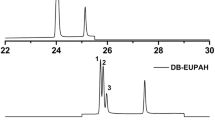Abstract
This paper reports a simple, fast, and inexpensive method for the determination of polycyclic aromatic hydrocarbons (PAH) in edible oils. The sample was dissolved in solvents, and a portion of the solution was loaded onto a solid phase extraction cartridge. The oil from the cartridge was washed away by isooctane/cyclohexane mixture and the absorbed PAHs were eluted with hexane/ dichloromethane mixture. GC-tandem MS was used to analyze 15 PAHs of EU priority in sesame oil and perilla oil. Analytical limits of determination (LOD) were 0.01–0.06 μg/kg, limits of quantitation (LOQ) were 0.03–0.17 μg/kg, and the recovery values ranged 55.1–105.0%. This method was validated using the certified reference material (CRM) and the error values ranged 2.06–4.30%. Twentyone commercial samples were analyzed to determine their PAHs contamination levels. The total concentration of the 15 PAHs in commercial samples ranged from not detected to 9.627 μg/kg. Only 1 sample had excessive benzo(a)pyrene content, which was more than 2.0 μg/kg.
Similar content being viewed by others
References
European Commission (EU) Opinion of the Scientific Committee on Food on the risks to Human Health of Polycyclic Aromatic Hydrocarbons in Food (2002). Available from: http://ec.europa.eu/food/food/chemicalsafety/contaminants/out153_en.pdf. Accessed Mar. 15, 2011.
KFDA. Korean Food Code. Korean Food & Drug Administration, Cheongwon, Korea (2005)
Daniel MB, Ricardo JC, Annibal DPN. Multivariate optimization of a liquid-liquid extraction of the EPA-PAHs from natural contaminated waters prior to determination by liquid chromatography with fluorescence detection. Talanta 74: 1392–1399 (2008)
Silva AVT, Natali GS, Milton BN, Ingrid SDL, Fernanda ML, Regina PZF. Polycyclic aromatic hydrocarbons (PAHs) in sugarcane juice. Food Chem. 116: 391–394 (2009)
EI Harrak R, Calull M, Marce RM, Borrull F. Determination of polycyclic aromatic hydrocarbons in water by soild phase extraction membranes. Int. J. Environ. An. Ch. 64: 47–57 (1996)
Cortesi N, Fusari P. Determination of polycyclic aromatic hydrocarbons: Utilization of lipidic matrix eluents with a lower environmental impact. Riv. Ital. Sosstanze Grasse 81: 145–147 (2004)
Justin KH, Daniel G, Bertrand H, Valerie C. Modeling the formation of some polycyclic aromatic hydrocarbons during the roasting of Arabica coffee samples. J. Agr. Food Chem. 56: 3648–3656 (2008)
Ledicia RS, Elena MC, Mercedes SGF, Carmen GB, Jesus SG. Occurrence of polycyclic aromatic hydrocarbons and their hydroxylated metabolites in infant food. Food Chem. 115: 814–819 (2009)
Husam A, Sameer A, Suad AH, Sahar Z, Wajih S, Nisar A, Kurunthachalam K. Concentration and dietary exposure to polycyclic aromatic hydrocarbons (PAHs) from grilled and smoked foods. Food Control 22: 2028–2035 (2011)
Jira W, Ziegenhals K, Speer K. Gas chromatography-mass spectrometry (GC-MS) method for the determination of 16 European priority polycyclic aromatic hydrocarbons in smoked meat products and oils. Food Addit. Contam. 25: 704–713 (2008)
Santino O, Viviana PC, Loredana C. Polycyclic aromatic hydrocarbons (PAHs) in coffee blew samples: Analytical method by GC-MS, profile, levels, and sources. Food Chem. Toxicol. 47: 819–826 (2009)
Gianfranco D, Giampiero S, Rossana S, Giuseppe G, Luigi T, Giacomo M. Isotope dilution determination of polycyclic aromatic hydrocarbons in olive pomace oil by gas chromatography-mass spectrometry. J. Chromatogr. A 1062: 247–254 (2005)
Bruno V, Aline B, Ludovic S, Vincent V, Fabrice M, Philippe M, Francois A, Bruno Le B. Innovation method for determination of 19 polycyclic aromatic hydrocarbons in food and oil samples using gas chromatography coupled to tandem mass spectrometry based on an isotope dilution approach. J. Chromatogr. A 1149: 333–344 (2007)
Lidia W, Monika GP, Piotr K, Jacek N. Problems of PAH quantification by GC-MS method using isotope-labelled standards. Talanta 78: 730–735 (2009)
Rubert S, Soja P, Elke A. Single-laboratory validation of a gas chromatography-mass spectrometry method for quantitation of 15 European priority polycyclic aromatic hydrocarbons in spiked smoked flavourings. J. Chromatogr. A 1103: 307–313 (2006)
Rubert S, Soja P, Elke A. Method validation for determination of the European-priority polycyclic atomatic hydrocarbons in primary smoke condensates by gas chromatography/mass spectrometry: Interlaboratory study. J. AOAC Int. 89: 772–781 (2006)
International Conference on Harmonization of Technical Requirements for Registration of Pharmaceuticals for Human Use (ICH). In: Validation of Analytical Procedures Methodology. Geneva, Switzerland (1996)
Author information
Authors and Affiliations
Corresponding author
Rights and permissions
About this article
Cite this article
Jung, SY., Park, JS., Chang, MS. et al. A simple method for the determination of polycyclic aromatic hydrocarbons (pah) in edible oil employing solid phase extraction (SPE) cartridge purification. Food Sci Biotechnol 22 (Suppl 1), 241–248 (2013). https://doi.org/10.1007/s10068-013-0073-1
Received:
Revised:
Accepted:
Published:
Issue Date:
DOI: https://doi.org/10.1007/s10068-013-0073-1




